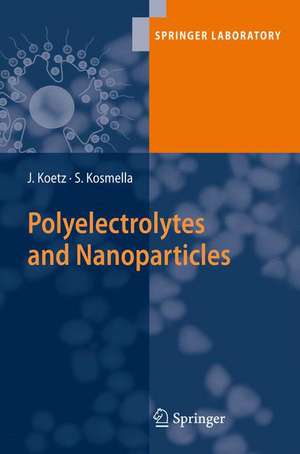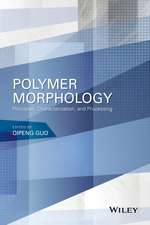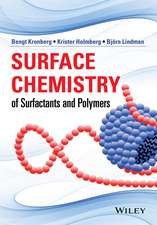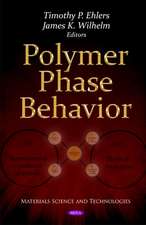Polyelectrolytes and Nanoparticles: Springer Laboratory
Autor Joachim Koetz, Sabine Kosmellaen Limba Engleză Hardback – 9 feb 2007
| Toate formatele și edițiile | Preț | Express |
|---|---|---|
| Paperback (1) | 378.34 lei 6-8 săpt. | |
| Springer Berlin, Heidelberg – 30 noi 2010 | 378.34 lei 6-8 săpt. | |
| Hardback (1) | 384.86 lei 6-8 săpt. | |
| Springer Berlin, Heidelberg – 9 feb 2007 | 384.86 lei 6-8 săpt. |
Din seria Springer Laboratory
- 15%
 Preț: 637.75 lei
Preț: 637.75 lei -
 Preț: 383.93 lei
Preț: 383.93 lei - 18%
 Preț: 783.05 lei
Preț: 783.05 lei - 15%
 Preț: 645.47 lei
Preț: 645.47 lei -
 Preț: 394.29 lei
Preț: 394.29 lei - 15%
 Preț: 642.18 lei
Preț: 642.18 lei - 18%
 Preț: 785.11 lei
Preț: 785.11 lei -
 Preț: 384.48 lei
Preț: 384.48 lei - 15%
 Preț: 636.92 lei
Preț: 636.92 lei - 15%
 Preț: 645.60 lei
Preț: 645.60 lei - 15%
 Preț: 660.49 lei
Preț: 660.49 lei - 15%
 Preț: 642.51 lei
Preț: 642.51 lei - 18%
 Preț: 953.65 lei
Preț: 953.65 lei - 18%
 Preț: 895.76 lei
Preț: 895.76 lei - 15%
 Preț: 645.79 lei
Preț: 645.79 lei -
 Preț: 389.49 lei
Preț: 389.49 lei - 15%
 Preț: 644.30 lei
Preț: 644.30 lei -
 Preț: 385.84 lei
Preț: 385.84 lei - 15%
 Preț: 580.46 lei
Preț: 580.46 lei
Preț: 384.86 lei
Nou
Puncte Express: 577
Preț estimativ în valută:
73.65€ • 79.97$ • 61.87£
73.65€ • 79.97$ • 61.87£
Carte tipărită la comandă
Livrare economică 22 aprilie-06 mai
Preluare comenzi: 021 569.72.76
Specificații
ISBN-13: 9783540463818
ISBN-10: 354046381X
Pagini: 124
Ilustrații: XVII, 105 p.
Dimensiuni: 155 x 235 x 14 mm
Greutate: 0.34 kg
Ediția:2007
Editura: Springer Berlin, Heidelberg
Colecția Springer
Seria Springer Laboratory
Locul publicării:Berlin, Heidelberg, Germany
ISBN-10: 354046381X
Pagini: 124
Ilustrații: XVII, 105 p.
Dimensiuni: 155 x 235 x 14 mm
Greutate: 0.34 kg
Ediția:2007
Editura: Springer Berlin, Heidelberg
Colecția Springer
Seria Springer Laboratory
Locul publicării:Berlin, Heidelberg, Germany
Public țintă
Professional/practitionerCuprins
and Objective.- Polyelectrolytes.- Nanoparticles and Polyelectrolytes.- Characterization of Polyelectrolyte-Modified Nanoparticles.- Fields of Application.- References.
Textul de pe ultima copertă
This lab manual guides chemists through demonstrations of synergistic effects between polyelectrolytes and nanoparticles. After a short introduction into the field of polyelectrolytes and polyelectrolyte characterization, the role of polyelectrolytes in the process of nanoparticle formation is discussed in more detail. However, polyelectrolytes can directly influence the growing of nanoparticles and also can stabilize the nanoparticles formed. Therefore, the nanoparticle formation in polyelectrolyte-modified template phases, e.g. microemulsions, is of growing interest. Finally, methods for characterization of the polyelectrolyte-modified nanoparticles are explained. The adsorption of polyelectrolytes can be detected by measuring the zeta potential at the nanoparticle surface by means of electrophoretic light scattering, acoustophoresis or streaming potential measurements. It is also shown that the particle size and particle size distribution can be determined by using dynamic light scattering in combination with electron microscopy. Moreover, all methods and preparation techniques are discussed in sufficient detail to give readers deeper insight into the methodical background.
Caracteristici
First book on the topic giving practical descriptions as well as tips and tricks The combination of polyelectrolytes, microemulsions and nanoparticles Methodical background of the methods used in combination to direct instructions for the sample preparation Includes supplementary material: sn.pub/extras









